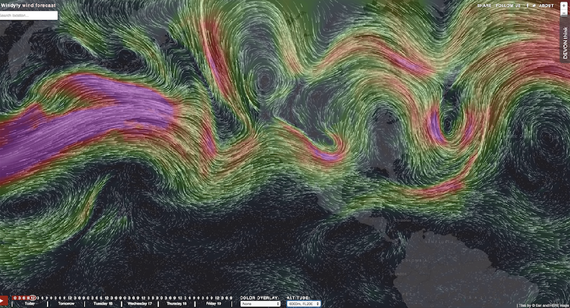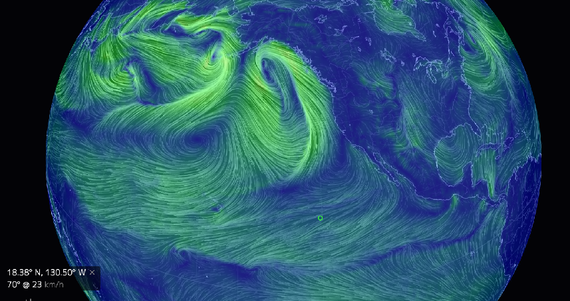By the classification rules of the world of physics, we all know that the Earth's atmosphere is made of gas (rather than liquid, solid, or plasma). But in the world of flying it's often useful to think of air as a fluid.* Landing with crosswinds in an aircraft has some similarities to tacking in a sailboat. The turbulence created by high winds over rough terrain is easiest to understand if you think of it as the counterpart to the whitewater rapids created when water flows over stones. [*Thanks to physics-world friends who have written in to emphasize that both gases and liquids can be fluids. I'm meaning to emphasize the visible-flow nature of air streams that these sites highlight.]
This is my way of introducing an absolutely fascinating site that depicts wind flows around the world as visible currents. It's called Windyty, it is a non-commercial project by an avid kite-skier and pilot in the Czech Republic, and the link is here.
The image at the top of this item is a static screenshot. If you play around with the site, as I predict you'll want to, you will see that you can pan and zoom all over the place, you can choose different color overlays to show different values—wind speed, moisture etc.—and you can see how things look at different altitudes. For instance, the opening image shows surface-level winds. Here is the view at 20,000 feet, dramatizing the increase in wind speed as you go up (with North America still at the center of the shot):

The real breakthrough of this site, for non-weather-professional viewers like me, is depicting atmospheric flows as if they were movements of liquids. Once you see the movement and currents depicted here, you'll think of the big H's and L's on weather maps in a new way. You can also click on specific locations on the map to get very interesting-looking local forecasts. Here is a video from Ivo, the adventurer and programmer in Prague who has created Windyty:
Windyty, wind forecast from Ivo on Vimeo.
And one more: If you'd like to see a similar animation presented on a globe, try this site, from the Earth community. Here's a sample:

Thanks to Mike McCoy, of UC Davis and the California Strategic Growth Council, for pointing these out.
This article was originally published at http://www.theatlantic.com/technology/archive/2014/12/envisioning-a-river-of-air/383739/
